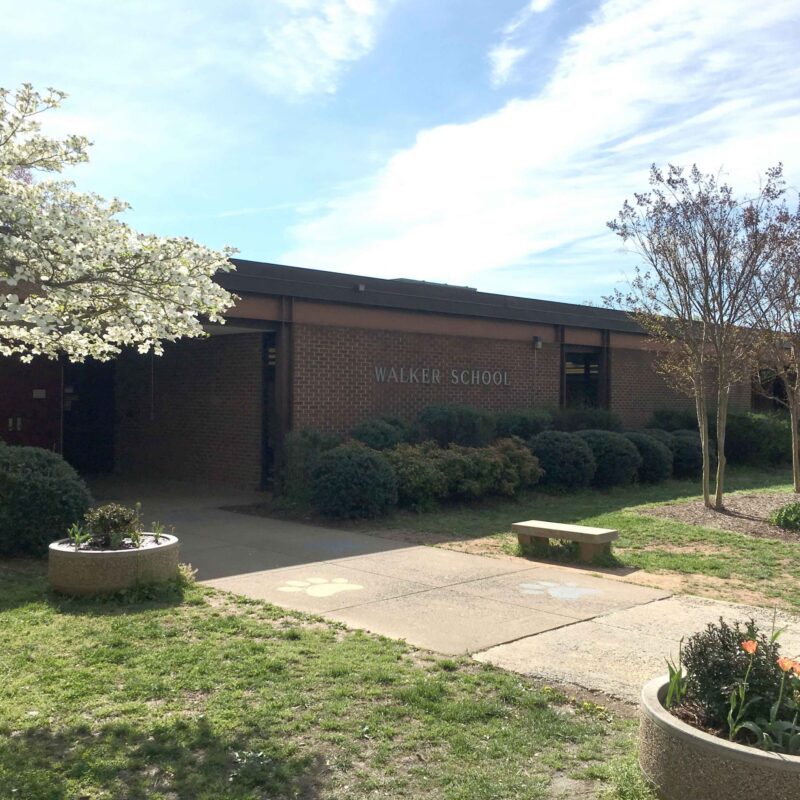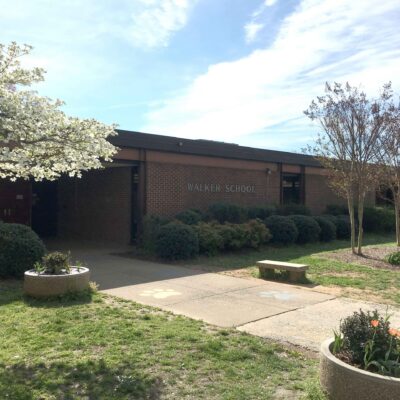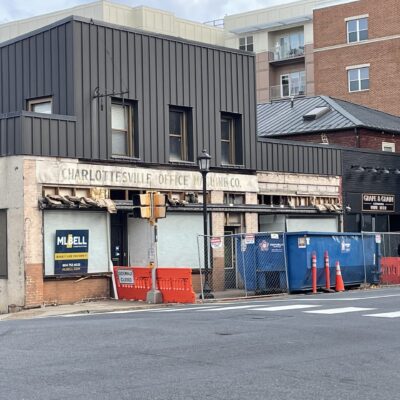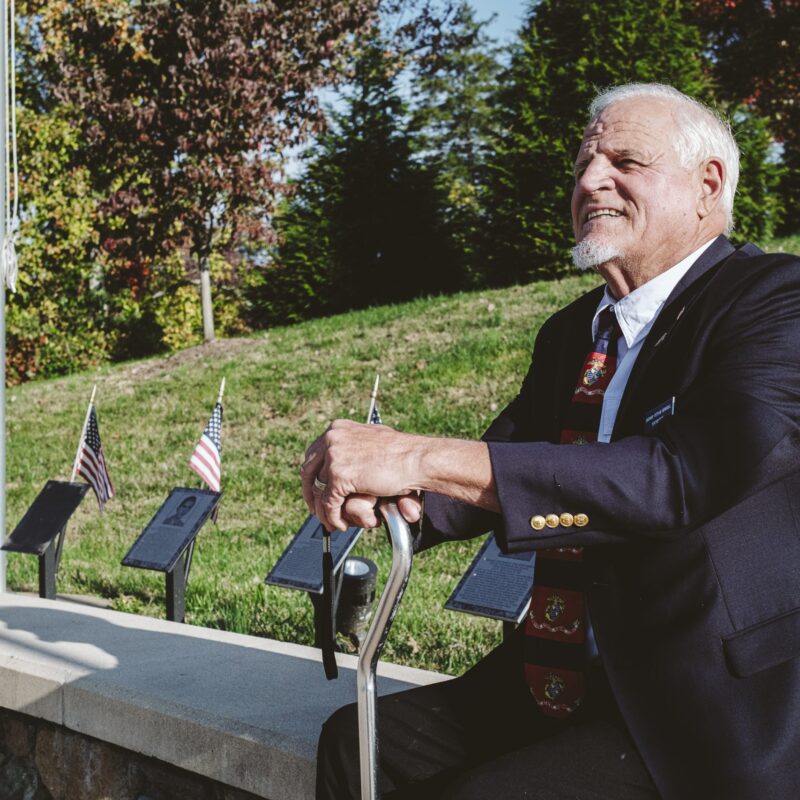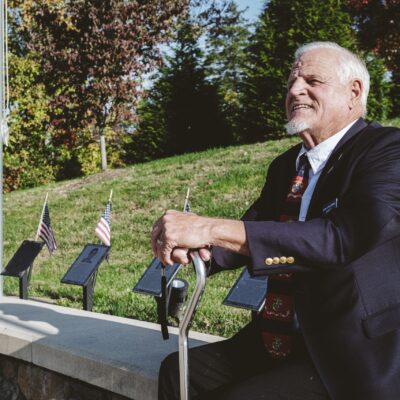When I was given the assignment of traveling to a local elementary school to square dance, the first thing I did was panic. (I’m not much of a dancer, or at least it terrifies me.) The second was to go home and beg my girlfriend to come along. Fortunately, she had nothing else to do on that evening, or at least she had no excuse—I knew for a fact that she had already washed her hair—and so she grudgingly agreed.
|
|
When the night rolled around, I wore a new seersucker shirt, khaki pants and suede shoes with worn tread, a close variation on my normal getup that might pass for country dress. My old lady donned her closest approximation of a southern belle’s sundress—a grayish number that left her tattoos exposed. The plan: Take the trip up Route 29 to Woodbrook Elementary School, for a Wednesday lesson with the Virginia Reelers. After two hours I would emerge unchanged by the experience.
We entered the stuffy scene in the modest gymnasium, where a woman was cutting a cake into large pieces beside the double doors that led to the kids’ bathrooms. I looked about in horror: A group of about 40 people, some wearing plastic nametags. All laughing, mingling freely, enjoying each others’ company. Some claim it to be the oldest square dance club in the state and perhaps East of the Mississippi, and many have been members for decades.
We stood at the nexus of a yawning generational gap. Square dancing is down from its peak of around 1 million dancers in the 1970s, to about 300,000 dancers now. The United Square Dancers of America conducted a survey in 2005 that found only 36 percent of square dancers were under the age of 60 in 2005, with less than 1 percent between the ages 19 and 29. The result? A quintessentially American activity faces obscurity in the hands of younger generations indifferent to good, clean fun. Or, it seems, indifferent to square dancing.
Soon I was treated to a big grin and a firm handshake by Steve Valorz, president of the Virginia Reelers, through whom I had arranged our visit. Valorz looked prim and fit in a salmon polo, and offered a brief anatomy of the crowd in a Boston accent: There was the caller, who stood with a microphone near a small P.A. The snack table, yonder. The group was split between novices and those who square dancers refer to as “Angels,” the folks with permanent nametags who usher the uninitiated through the first calls, and the students.
Another moment passed and we were approached by a trim older couple with glowing smiles. The Faulkners. They’ve been dancing with the Virginia Reelers for six years. My partner was whisked away by John. His wife, Nancy, grabbed my hand from beneath as if to lead me through leading her. (Make no mistake: the men do lead.)
Soon the casual mayhem of social interaction had coalesced into four distinct squares, each side of which was formed by a pair of dancers. At the microphone a man named George Jordan, the caller, began to issue gibberish orders. As my girlfriend walked off hand-in-hand with John, I knew: This was the point of no return. I was just a postmodern kid, far from irony’s safety net in a world of squares.
First up was “Dosado”—the only square dance call that most non-square dancers know—where two partners stand shoulder-to-shoulder, and circle around one another in opposite directions. With my big, fat left feet, I feared that I might trip poor Nancy from behind. But as a joyful, instrumental country tune plucked its way through the room, we ran through the move a couple of times. With each full circle, dear Nancy greeted me with a shallow bow and smile. I returned each one, at first in spite of myself, and then more naturally.
There were three other calls in the first several minutes: the Star Promenade, where the men raise their arms and grab each others’ wrists; the Pass Thru, where pairs switch places with another, passing shoulders on the right; and the Separate, when pairs turn their backs to each other and circle the square. Our first round was through after about 20 minutes of hand-grabbing and spinning. I thanked Nancy—a worthy Angel, indeed.
Valorz found me again. “Are you having fun?” he asked. I said that I was, to be polite. But where was my girlfriend? Who knew? I considered further. Why was my chest softly heaving? And that brisk pitter-patter in my cold heart? Why did my lips feel tight and my cheeks fat?
It was a smile.
An absurd and toothy, totally-loving-it idiot grin.
“Friendship set to music”
If the machines of vintage fetishism catch square dancing in its sights, we’ll all be buying swirl skirts and bolo ties at Urban Outfitters. Think of the hordes of young people who have taken artifacts of “the way things used to be” and made them hip again. The interest in the pure physicality of, say, vinyl records—now a fad among young music collectors—would only need to be slightly tweaked to get young people reveling in the purely physical joy of holding hands with a complete stranger. The complexity of square dancing echoes that of knitting, also very “in,” very vintage, very physical. To say nothing of the rural revival among young organic freaks, who could conceivably get into a form of dance whose seeds were sown on the rural land they work.
|
Steve Valorz describes Virginia Reelers co-president Glenn Thomas (pictured) as the “face of the operation.” Attached to his nametag are “dangles,” small badges of honor that display a dancer’s accomplishments. One dangle on the top left shows the face of the club’s caller, George Jordan.
|
And for now, the club is trying to engage younger people as interest continues to decline. “What we’re trying to do with our club is to break down the barrier, that perception that square dancing is for an older audience, and get young people involved.”
Valorz and his wife have a 19-year-old son who just started college. “He thinks it’s kind of a kick telling his friends that we’re square dance presidents. I think he appreciates and respects it. But, again, at 19, he thinks it’s a little bit strange.” But only a monster could have escaped the scene at Woodbrook Elementary uncharmed by the simple elegance of the dance, the snacks and the kind conversation. In chats with several longtime Reelers, square dancing at Woodbrook Elementary was described as everything from a secular stand-in for going to church, to “friendship set to music.”
There is also a good spirit of competition. I asked various dancers if there was a single square dancer who was better than the rest. Everybody seemed to blush at the thought of it; square dancing is a perfectible art, so when someone makes a mistake, he or she simply lacks training.
Whenever a team organizes a complete square for a nearby club’s square dance—one couple per side of the square, which makes for eight people per square—they take home the banner of the hosting club. The Virginia Reelers have been known to accumulate as many as four rival banners. This ongoing game of capture the flag goes far toward the form’s communal aspects, specially designed to make people feel comfortable; really, to have fun with each other, even beyond the Charlottesville community.
Ed Hineline is perhaps the longest serving member of the Virginia Reelers. At the lessons, Hineline went through the motions with the stubborn confidence of a man forging forward in spite of his age. (He looks good, but said he retired in 1988.) Hineline has been a member of the club since about 1970, when the Reelers met in a church near Downtown. He’s been a consistent member of the club since then, except for 10 years, when a “divorce situation” took him out of town.
“When I didn’t have a partner, then I didn’t dance for a while,” says Hineline. “And now I’ve been back for—oh gosh—I don’t know how many years.” (Around 20, he later remembered.) It took time to get back in the fold, but when he did, he was soon dancing with one of the singles. There’s always at least three or four to choose from, he says. “I do have a partner now,” he says. What does he like about it? “The sociability. The contact with people,” he says. “Just about the only friends I have are people from square dancing.”
And football, it ain’t. The gravest injury that anybody could recall among the Virginia Reelers was when a former club president, getting on in years, tangled feet with his wife and wound up on the floor with a chipped tooth. The pair had been attempting the Virginia Reel, which introduces vaguely equine footwork to the pastiche of spinning and grabbing that characterizes basic square dancing fare.
It’s also healthy. Valorz says he and his wife, who teaches aerobics at ACAC, began square dancing about six years ago, when they were looking for an alternative date night. “We had been looking for an opportunity to do something, and we were tired of movies and going to dinner. And one of the ladies in the class invited her to the open house two, maybe three years ago.” At first, Valorz and his wife watched from the sidelines. “And then they dragged us up there.”
Like so many before him, the unsuspecting Valorz caught the bug. “I never thought I would find myself square dancing,” Valorz says. “But when it was all said and done, I said to myself, ‘Man, this is kind of fun.’ And it was active—it wasn’t like we were sitting there not talking to each other. We laughed, had some good times.
“We took the class, and the rest is history for us.”
John Faulkner—who I have since forgiven for stealing with my girlfriend—is a retired UVA mathematics professor who says that, aside from the camaraderie, it’s the geometry that appeals to him. The dances themselves are brain exercise. Pay close attention to the calls and it’ll keep you mentally acute. In particular, the logic of the “Grand Square” doesn’t reveal itself to a new dancer—I have the bruises to prove it—but as we repeated the move, galloping in and out of four interlocking and slowly unfolding squares, I began to envision the kaleidoscopic complexity of the move and felt stimulated, like I was playing with Legos.
Time takes the square
If square dancing has a foil, it’s that same big, sad fact of modern life in America: It’s hard as heck to get people to get in a room together. But it hasn’t always been this hard. Phil Jamison, an Appalachian studies scholar at Warren Wilson College told the Wall Street Journal last year that the story of square dancing begins in 18th-century France, when quadrilles—with four pairs to a square—were all the rage. (That’s where French phrases like “dosado,” “allemande” and “promenade” come from.) Meanwhile in America, various folk dances took the square shape, and dancers were accompanied by mostly African-American bands and, eventually, callers.
Partner dancing in general suffered setbacks in the Puritanical late 19th century, when ladies were not to be touched. But as the early 20th century rolled around, the form found a muse that would change everything: Henry Ford. Ford no doubt liked square dancing’s quinessential Americanness, as much as he did its resemblance to an assembly line. By the early 1920s, Ford hired a caller and sponsored a radio program, in which the caller would name steps that had been printed in the paper the previous week. Eventually his friend Thomas Edison started producing 78rpm square dance records.
|
Where to get your folk dance fix The square dancing season begins with classes each autumn and runs through the spring. That’s when clubs would traditionally host a big dance, an opportunity for students to show off the moves they learned at classes during the cold months. A few local clubs offer opportunities to learn the basics of square and other folk dances. The Virginia Reelers (Charlottesville) meet throughout the season for lessons and dances, sometimes with live music. Visit the club’s website at www.virginiareelers.com for information on lessons and regional dance events. The Virginia Square and Round Dance Association is a good resource for regional folk dance events. Find out more information about other local clubs, like the Greene Cloverleafs, Fluvanna Flutterwheels and Rivermont Ramblers, at vasquaredance.com. Contradancing is a paired folk dance that’s similar to square dancing, and has a similar family-friendly atmosphere. At the Contra Corners’ website (www.contracorners.com) is a helpful list of upcoming dance events throughout the region, including workshops, contra dances and waltzes on the third Friday of every month. On Saturdays at 10am and Thursdays at three minutes before 2pm, WTJU 91.1FM airs Folk Dance Calendar, with information on upcoming contra and square dance events, as well as English, Scotch, Irish and international folk dancing. |
With these advancements Modern Western square dancing was born, with its emphasis on exhibition and costumes, prerecorded music, and clubs that offer lessons so dancers can master difficult steps. A fad had taken flight that would continue through the the early 1980s. President Ronald Reagan briefly named square dancing American’s national dance in 1982.
Several longtime dancers reckoned that the largest events took place in the late 1970s, when regional clubs, including the Reelers, each hosted yearly events. That’s also the period when two local callers decided to devote their lives to square dancing. George Jordan started calling in 1969, and now calls for lessons for the Virginia Reelers. He says that, for years, he’s been putting anywhere between 25,000 and 40,000 in highway miles on his sedans, traveling from his home in Staunton to clubs in Waynesboro, Palmyra, Charlottesville, and events in West Virginia.
The things he likes about square dancing have been a constant ever since. “There might be professors, doctors, lawyers, and the guy who digs a ditch, but they’re all square dancers. It’s like a big family.” He says he loves dancing because no matter where you go, it’s the same; even Japanese callers call in English. (The more than 100 calls have been standardized by a Topeka-based group called CALLERLAB.) Clubs formed throughout the 1950s and ’60s to teach aspiring dancers the moves they would need to enjoy big regional dances, and, according to Jordan, Charlottesville’s was the biggest. “The goal of the clubs was to get ready for Charlottesville’s festival,” says Jordan. “Later on, the other clubs started to have them, but Charlottesville’s was always the big one.”
And the big dances were beautiful, says Jordan. Imagine about 1,000 dancers—or 125 squares—all dressed to the nines: The men wore Western shirts, and cowboy boots, and the women wore big dresses that flared with each twirl. All-day dances would last well into the evening and were followed by parties at friends’ houses.
“Once you belong to something, you find out how deep it goes. It just depends on how much you want to get involved,” says Larry Winegard, who has worked as a caller since the early 1970s. Winegard guest calls the Virginia Reelers about twice per season. “I’ll call anywhere within a 200-mile radius,” he says. He is on the road sometimes six or seven nights per week—it’s more like two or three in the off-season—at clubs in Stanardsville, Afton, Timberville and Locust Grove.
When Winegart got involved, in 1971, “Square dancing at that point was really on the upturn. Forty years ago, there wasn’t as much to do as there is now.” Winegard compares the declining interest in square dancing to something he read recently: Churches started experiencing a decline in numbers around 1985. “Because of videos, and the entertainment that’s available, and people becoming busier—both people in the family working—and any number of things, activities started to go down.”
He says the downturn leveled off around the turn of the millenium. Though you won’t find dances with 1,000 people, “You can find clubs within a 60 or 80 mile radius of Charlottesville, there’s anywhere between 10 and 15 clubs, and a club will range from 20 to, say, 100 members.”
|
What’d the caller say? Whether you travel to Greene County or Greenland for a square dance, calls are the same everywhere. Here are a few selections from CALLERLAB’s “Advanced Definitions,” the widely accepted standard for square dancing calls. Callers attend intensive classes to learn how to deliver these instructions to dancers on the fly. All 8 Dixie Style To A Wave Explode and (Anything) Double Star Thru Horseshoe Turn |
Hip to be square?
Halfway through the evening a young couple walked into Woodbrook. Asked if she was the youngest member of the Virginia Reelers, Kendall Singleton laughed and said, “Why, yes.” She and her boyfriend joined in 2008 when she saw an event listing a free class for the Reelers, only ever having contra danced; they bravely became part of the 1 percent of square dancers in their twenties.
Though they like the intellectual challenge, she says they’ve had trouble recruiting friends. What do her peers think? “I guess they’re glad we’ve found something fun and low key and entertaining, and they usually seem excited—or at least understand that we’re having a good time,” says Singleton. “But they’re not interested in joining themselves, mostly for the time commitment.” She says that the schedule wouldn’t work for most of her peers, since you have to return each week to memorize moves, which is better suited to young people more on the “settling down” end of things.
But that’s a commitment many young people may be unwilling to make, as the “settling down” time only grows increasingly hectic. Most would sooner rent an instructional square dancing video from Netflix than don western wear and travel to the local elementary school for lessons.
Nonetheless, in her third year Singleton has earned the title of Angel, so that she can teach newcomers. If any of her peers should follow her, they might end up being angels in a broader sense, rescuing a historically rich art form—and a downright wholesome time—from going down the one-way path to obscurity.
During my lesson, things grew trickier as the night went on. At first I was nearly killed by the “Allemande Left,” an impressive call where men turn counter-clockwise and weave through a circle of women spinning in the opposite direction. The move resolves into a promenade, wherein the man guides the woman back to the pair’s correct position in the square as if she is blind. As the moves ran their course the caller reverted to ad-libbing over the karaoke-style accompaniment. “The best things in life are free,” the caller sang in the calm and comforting voice of a man who’s sang this song a thousand times. Later came “Down in the boondocks.”
I didn’t have a moment to think about the irony of me, square dancing, or that my partner, who appeared to be in her 70s, was putting me through the ringer. I couldn’t even think about that story I would write. All I could think about was executing the maneuvers issued from the P.A., over karaoke music, and bowing to my partner. Ah, square dancing! The panacaea for all of my postmodern woes.



 George Jordan has been a professional caller since 1969, after graduating from caller school in New Hampshire. Jordan started by lugging around 78rpm records, but now has his music loaded onto a Swedish computer program called SqView—pronounced “square view”—that allows callers to loop a song, and to adjust tempo. Many callers still carry the records, just in case.
George Jordan has been a professional caller since 1969, after graduating from caller school in New Hampshire. Jordan started by lugging around 78rpm records, but now has his music loaded onto a Swedish computer program called SqView—pronounced “square view”—that allows callers to loop a song, and to adjust tempo. Many callers still carry the records, just in case.